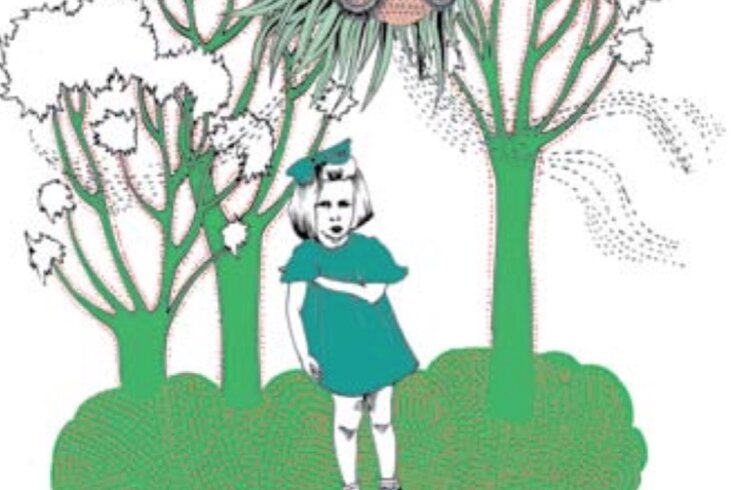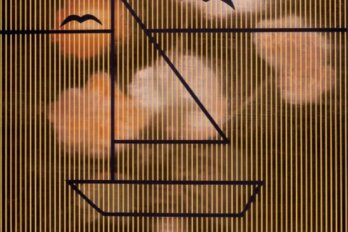On top of the TV there was a picture, colourized and framed, of baby Gail sitting on my father’s knee, with her name printed in the top right corner: “Gail Gallant at 3 months.” There were pictures of my parents, scarred and on crutches against floral wallpaper. The scar had left my mother’s smile unbalanced, a half-smile. Our family photo album had pictures of a gravestone on which “Gail Gallant” was clearly etched, though no one visited her grave. There were stories about the accident that summer and stories about my birth the following year. Did my mother really believe that I was Lazarus, her one and only baby Gail, back from the dead?
On a July night in 1955, my parents, Lawrence and Maria Gallant, were driving eastbound on the highway from Toronto to Prince Edward Island in their weeks-old Ford Fairlane. It was the first day of their vacation, and their three daughters were with them. Two-year-old Glenna was asleep in the back seat. Four-year-old Linda was restless, so my mother reached back and gave her a rosary. The four-month-old baby, Gail, was bundled and sleeping, in those pre-baby-car-seat days, between my parents on the front seat.
My mother was drifting off when the crash occurred. The impact was head-on, and then she found herself on her hands and knees, looking up through the smashed windshield at mangled metal. There was screaming and crying from the back seat, and in the front seat, blood, glass, and broken bones. My mother’s cheek was cut open from cheekbone to mouth. His foot broken, my father tried to open the back-seat door but couldn’t. He thought of gasoline and fire, and in a reflex move, smashed the window with his elbow. My mother looked for her baby and saw her on the floor, where she had fallen after hitting the dashboard. She tried to reach down but couldn’t move her arm. Strangers from a nearby diner surrounded them, yelling and pounding and pulling at the doors until they opened. Someone reached in and took the baby.
At the hospital in Montreal, doctors picked glass out of my mother’s face. (She would never believe they’d removed it all.) My father had more than thirty stitches. The broken bones were set. My parents returned to Toronto several days later by train with two of their daughters. The baby stayed in intensive care in the hospital with a severe skull fracture.
All through that hot Toronto summer, my parents called the hospital daily. Weak and with burning pain, my mother delirious with anxiety, they travelled by train to visit Gail. They signed consent forms for her surgery. My mother sat at the bedside, talking sweetly to her through tears, until Gail slowly opened her eyes. Her condition was serious but stable. Surgery was performed. It was counted a success. My mother picked out a pink frilled baby-doll dress and bonnet for her homecoming.
Gail had been in the hospital for more than a month when my parents got a call saying she would be discharged the next day. The following afternoon, while they were waiting for the taxi to take them to the train station, the phone rang. It was Gail’s doctor. “Your daughter has a high fever and is having convulsions,” he said. Tests confirmed that she had contracted meningitis. Disbelieving, my parents travelled to Montreal. At the hospital, they looked down at their baby’s face. She lay in cherubic repose, the picture of perfect life.
For the next month, my mother staggered to daily Mass, prayed, cried, and begged God not to take her baby. Gail remained comatose. Finally the parish priest, who had been watching my mother’s agony, put a hand on her frail shoulder as she shook in the pew, and recommended that she let Gail go back to God. The doctors could not make the baby better again. Only God could do that.
Gail died two days later, on August 15, 1955. She was buried in her coming-home outfit. For the next two months, my mother barely ate or slept. She prayed. By October, she was pregnant again. No one talked of nervous breakdowns, except perhaps several neighbours who came over to the house one afternoon to express concern that my mother’s daughter, Linda, was telling children on the street that Gail was coming back. What if she gave birth to a boy? My mother assured them she was having a girl.
Apart from the initial visit to confirm the pregnancy, she saw no doctor during the next nine months. She had given birth three times and knew what to expect. But when her water broke late one July night, she was frightened. Labour hadn’t begun yet. She called the hospital and was told to come in right away. It was 3:30 a.m. A doctor examined her and told the nurse to take my mother into the delivery room immediately. She was fully dilated. The child was ready to be born, but my mother wasn’t having any labour pain. In those days, women in delivery were given a short-term general anesthetic during the final minutes of birth. The anesthesiologist waited as the minutes ticked by, waited for a contraction that would signal the need to bear down. He sang “Jimmy Crack Corn” and joked that if the baby wasn’t born by 4 a.m., he was going home. At one point, she felt a strange sensation across her abdomen, like “pins and needles.” Otherwise, nothing. The doctor said, “Everything else is going your way, what do you want? ” A seven-and-a-half pound, dark-haired baby girl.
That was her last memory before waking up a half-hour later, with me lying in a basket beside her, eyes wide open, looking around. A miracle birth. A birth without pain. And as my mother would say, an uncanny resemblance. It was inevitable that I would be named Gail.
Even as a young child I knew that I had been reborn. I spoke of it to no one and only my mother spoke of it to me, albeit obliquely. I also knew that I had died. God must have some plan for me, I thought, so I waited, timid and anxious. Meanwhile, there was nothing for me to do but get on with life. But how? When you’ve opened with your best act, what do you do next? The way came to me, enveloped me. The family rosary in the evenings, holy water by the light switch in the bedrooms, First Communion with white-gloved hands clasped in prayer. Confession, incense, and Latin hymns. Could I do pious? I was Bernadette. Lying in bed in the dark, I shook, staring into the corner of my room, terrified that the Virgin Mary would appear and tell me I had to leave home to convert Russia. I had a propensity for visions. I would search the clouds for signs, for suspicious rays of light. I expected miracles. I knew God could see me. I cried easily and often. I fainted periodically. I prayed. I dreamed I was a nun. I dreamed I was a saint, a martyr, even a saviour.
Having two Gails in the family was confusing, especially if we were really only one. I have an early memory of my mother asking me about the framed picture of the other Gail. It had disappeared from the top of the TV. I had no idea where it was. I remember my surprise when she found it face down, buried under clothes in my dresser drawer. For years after that, she hid the picture, putting it back out gingerly when I was an adult.
I started grade one at St. Francis Xavier when I was six, and cried daily for half a year. And at the end of the school year, the teacher presented me with a pale blue plastic shell that opened up to reveal the Virgin Mary and a crystal-coloured rosary. I had stood first in the class. My mother seemed pleased, though it was hard to tell.
My mother’s mother had died when she was eight. Her father’s house in rural pei, where she was the second-youngest of eight children and the only girl, was a rough, sometimes violent home. After her favourite older brother signed up for the war in Europe, her father donated the service pay to my mother’s education. She was sent away to a residential convent school on the northwest tip of the island, where she was raised and educated by nuns, clothed and fed on their bitter but sometimes soothing wisdom. Her gentle-hearted mother was gone and her father, an angry and heavy-drinking man who surely loved his only daughter, did not visit. Her first Christmas there, other girls celebrated with their families while my mother stayed at the convent. The nuns gave her explanations for her pain. God’s will must be done. You get what you deserve. And they told her to pray.
I had been painless. I had stopped the pain. Or had I? My mother rarely seemed happy. Through the 1960s, she raised seven children while my father worked six days a week managing a gas station. He came home late, stiff and numb with fatigue, and left in the morning before dawn. On Sundays, he rested in a solitary stupor. The summer I turned eleven, we moved into my mother’s dream home, a back-split in the Toronto suburbs with three bathrooms, five bedrooms, and a fireplace. But still there was constant tension, a fear of something breaking or snapping. In the summer of 1968, I walked to Mass each morning. I had recurring dreams of being a hero, saving Holocaust children from a burning schoolhouse and an axe-wielding Nazi madman. Dark hair, dark eyes, saving children’s lives.
Under the bed lay a frail, dark-haired secret. Long before E.T., I fed and clothed the alien in my bedroom, peering over the pages of the Sears catalogue for the coordinated turtlenecks and jumpers and stretch pants that I could afford to order for her on my imaginary tight budget. I took care of her. I imagined “the other Gail” as my twin, maybe an inch taller, but more fragile and in need of me. Dark hair, dark eyes, and the only two sisters in the family born without a birthmark. She aged in tandem with me. I was her guardian angel.
The death of the other Gail and my miracle birth had cut a swath through the family. The sibling rivalry for my mother’s approval was deadly and lent a chaotic shape to all our lives, but I felt I was the one to beat. I had two older sisters, two younger sisters, and two even-younger brothers. I made a mockery of birth-order theories. The order of my birth had traded a life for a death. Beat that. My mother gave little praise and few compliments, but I had her attention and I worked to keep it. My every success reinforced my mother’s silent story, keeping her guilt and pain at bay, but causing my siblings to resent me. Eventually I found the solution: nobody envies a sad person.
At fourteen, I read Plato’s Apology and named my cat Socrates. I fell in love with Lewis Carroll’s Alice books and memorized “The Walrus and the Carpenter,” reciting it to anyone who would listen. One minute life was dire; the next, absurd. I read Cardinal Newman and C.S. Lewis. But I had a cute track-star boyfriend who wanted to get married. I was publicly pious and privately libidinous. I didn’t know who I was.
It was inevitable that the teenage years would mark the decline in my relationship with my mother. Her unhappiness was like a knife hanging in the air. I tried to walk around it, but she seemed increasingly disappointed with her life, with us, even with me. “And we thought you were going to be a nun,” she once said bitterly.
My enjoyment of the Catholic Mass waned. I critically analyzed hymn lyrics during the car ride back from church. Still, I slept with a rosary under my pillow. At university—my first year of education outside a Catholic school—I started studying the Bible. My world split open. I remember the first Christmas I could no longer believe in the nativity story. I cried after midnight Mass. I’d read too much contemporary biblical scholarship, knew too much about the conflicting versions of Jesus’ birth in the Gospels of Matthew and Luke and its complete absence in John, Mark, and the Epistles of Paul. I had stepped out of the Catholic candlelight and into the dark freedom of post-Enlightenment literature. Kierkegaard, Dostoevsky, Nietzsche, Kafka, Heidegger, Eliot. It’s not that I believed in nothing, but why would God bring me back to life and not all the other babies who die? And what if I did nothing with my life to justify that miracle re-entry?
I drank too much coffee and lost weight; my hands shook. I had periods of severe insomnia, often falling asleep only after my father rose for work. I got through my undergraduate degree without looking up from books. I had no friends, and no social life other than quiet weekend evenings with that same old high-school boyfriend, watching sports on TV. I still said the rosary, but only in lieu of counting sheep. The Virgin Mary was, after all, so obviously a non-biblical construct.
But I began to sense that I could make a good first impression, especially with men. They seemed to like a little angst in a woman. It was the age of Annie Hall. I had been with my first boyfriend for six and a half years; the last year, we were engaged. I gave him back the solitaire engagement ring the month before finishing school.
I graduated with distinction from York University. On that day my mother, I felt, was proud. There is a photo: she with a tense half-smile; my father looking haggard and distracted; me grinning tightly. The dean of arts urged me to consider graduate school in New England. I knew that I wouldn’t. I wanted to stay close to home, close to my mother.
I married the next man I dated and stopped going to Sunday Mass. I got my driver’s licence, entered a graduate program in religious studies at McMaster University in Hamilton, and put forward “The Religious Significance of Doubt” as a thesis topic. I was busy reinventing my faith as a zealously guarded, dogmatically defended sense of loss. It was better than nothing.
In the end, I wrote my thesis on the French philosopher Paul Ricoeur, after discovering his book (co-authored with Alasdair MacIntyre) The Religious Significance of Atheism. My master’s year went well, but graduation left me disappointed. I became agitated by my less cynical colleagues. Only on the very edge of the precipice of despair could I find comfort. I switched my doctoral studies from theology to political philosophy, with a decidedly Marxist bent. I had my eye on the door. I began to spend more and more time alone at home, unable even to make eye contact with the grocery cashier.
Years later, I put aside my unfinished doctoral thesis for good and tried my hand at broadcasting. The work was intense, and at home I felt overwhelmed. I went to see a career counsellor and broke down in his office. Sobbing, I told him about the car accident. The intensity of my grief took me completely by surprise.
Anger at my mother finally flooded me. I’d spent my whole life trying to be someone else, trying to make her happy, trying to ease her pain. Over the next several years my life was filled with psychiatric appointments, antidepressants, and tranquilizers. During the worst times, there were daily imaginings of driving my car into cement uprights on the highway, of a knife plunged neatly into my chest, of being punched in the face. The thoughts were recurring, involuntary, pleasurable.
One Sunday afternoon, I sat slouched at my mother’s kitchen table. She was standing at the sink, her back to me. She said, very cautiously, “Maybe I made a mistake naming you Gail.” I felt a sharp panic, held my breath, and said nothing. Then I changed the subject, my heart pounding.
Three years later, a divorce and a Las Vegas elopement having cemented my failed Catholicism, I took my mother to a farm two hours from Toronto where signs of the presence of the Virgin Mary had been reported. It was my Mother’s Day present, our one and only outing together. We walked several acres of farmland, empty save for homemade stations of the cross spread out over the rolling fields and in the forest. We walked for an hour or so, saying little, pausing at each station as if to pray and then moving on. At one point we both smelled roses where there were none—the classic sign of the presence of Mary. We took the scent in stride, saying only enough to confirm it, and moved on.
For months afterward, I rarely saw my mother, and when I did she seemed unwell. She had chronic digestive problems and was losing weight. There were several diagnoses, but the final one was cancer.
My mother began to write her memoirs. For ten months, while undergoing chemotherapy, she sat daily at a word processor. I was afraid to read what she had written. We sat in the examination room and heard the doctor say, “You will die because of this tumour.” My mother and I leaned on each other, pressed forehead to forehead in silence.
She began telling her family that she loved us. She told me she loved me for the very first time. I told her I loved her for the very first time. We decided not to put her in the hospital. My sister Wendy, who was living at home, courageously learned how to operate my mother’s medical machinery and assumed responsibility for her care. Eventually we decided to take turns staying with her through the night. The first night, I slept beside her. The hum of her machinery—the IV, the pump administering morphine at intervals, the barely audible serenity tapes—produced a gentle sound. Her fingers often fumbled toward my pajamas, a silvery taupe paisley silk, a present from my husband. “Beautiful,” she said. “Is that pillow uncomfortable? ” she asked. “Are you managing to get any sleep? ”
In my forty-two years, I had never had an honest talk with anyone in the family about the other Gail, and no one had raised her with me. Now, she broke through to the surface. My eldest sister, Linda, my father and I were sitting in the family room. Linda put a question to my father, with a tone of slight agitation, as though it came from years of silent wondering: “What was going through your mind when Mom thought that the other Gail had been reborn? ” I braced for the answer to a question I had never had the courage to ask. My father hesitated for only a moment. “I guess I believed it too.” That’s all I needed to hear. I felt both intensely angry and relieved.
During those last days, there were always several daughters at my mother’s house. My father shuffled from room to room, mute, bleary-eyed, and in obvious pain. We sat by my mother’s bed, held her hands, gave her extra doses of morphine. One afternoon several of us sat with her as she drifted in and out of sleep. She opened her eyes and looked at me semi-consciously. Suddenly her face lit up in a wondrous smile. “My beautiful daughter,” she said. I didn’t care who she thought she saw. Was the other Gail, the baby Gail, calling to my mother from the other side? I’ve been waiting for you. I’ve been here all along. Silly mommy. I’m waiting for you. Is that how my mother realized, on her deathbed, that forty-three years ago she truly lost her baby?
On the night she was buried, Larry, my very sensible banker brother, dreamt that he walked into a white room and there my mother, baby Gail in her arms, reassured him that all was well. The doctor on call when my mother died told Linda he had been very moved by my mother. He said she died with great dignity. But it was so sad, so tragic that she’d been haunted her whole life by the death of a baby girl. All this time, I’d thought that baby girl was me.
Someone in the family wrote the death notice. I saw it only after it was published. It named the next of kin in order of birth, ending with a name that took me by surprise: Gail-Marie. I had never heard or seen the other Gail referred to as Gail-Marie. Later that day, I was staring at the picture, now framed on the wall, of the other Gail sitting on my dad’s lap, the same picture that had found its way into the bottom of my dresser drawer decades before. Between Gail and Gallant there was an arrow. I had to take the picture out of its frame to see what else was written. Marie. Strange. A different-coloured pen, a different style of writing, yet still unmistakably my mother’s hand. When did she decide the other Gail would be called Gail-Marie? No one had told me. Like the survivor of a delicate surgical procedure to separate Siamese twins, I felt like one person for the first time in my life. I was just one of the Gallant daughters. It was a healing, searing pain.
Months after my mother died, I found the courage to read the memoir she wrote during the last year of her life. It ends abruptly, right after my “miraculous” birth in 1956. She describes the birth of the first Gail, saying she was “amazed at the beauty of that sweet little child with her perfect little body and the face of an angel.” She says they named her Gail Bernice. But “Bernice” is my middle name. And of her darkest hour, while baby Gail lay dying in the Montreal hospital, my dying mother wrote, “I pleaded with God not to take our child… I was prepared to make a deal with the devil.”
At the funeral I cried through much of the service and thought briefly about how I’m no longer interested in the Father, Son, and Holy Spirit. But I still have a thing for the Blessed Virgin, Mother Mary. Yes, I think I still believe in Her. Her, and sometimes the devil.





